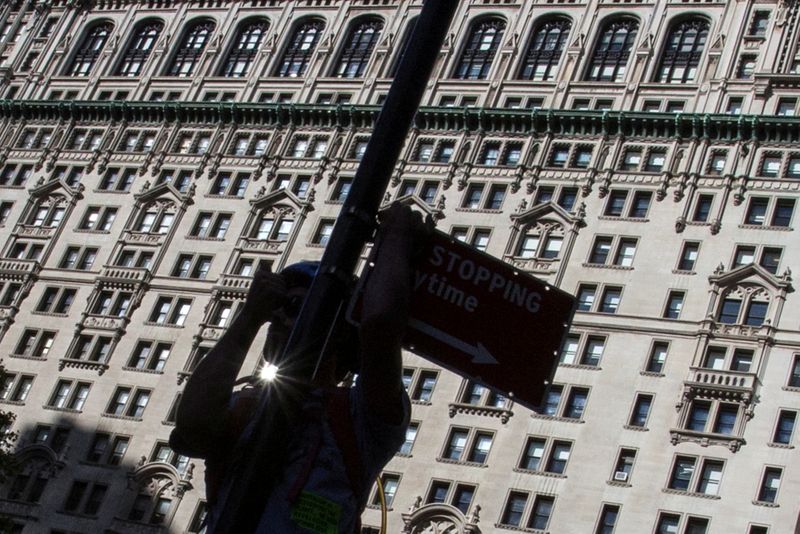 © Reuters Dow Jones, Nasdaq, S&P 500 weekly preview: Uncertainty increasing
© Reuters Dow Jones, Nasdaq, S&P 500 weekly preview: Uncertainty increasing
By Senad Karaahmetovic
U.S. stocks are enjoying an extremely volatile start to the new trading week. Investors are seeking shelter in gold and government bonds after the Silicon Valley Bank (NASDAQ:SIVB) collapsed, making it the biggest bank failure in the U.S. in 15 years. On the other hand, stocks pared gains after surging in pre-market Monday trading.
The S&P 500 closed over 4.5% lower last week, the biggest weekly decline since last September. Dow Jones Industrial Average lost about 4.4% while Nasdaq 100 fell 3.75%.
The Q4 2022 earnings season is almost fully completed now with FactSet estimating that the S&P 500 earnings declined 6.1%, which would be the largest decline since Q2 2020. On the valuation front, the forward 12-month P/E ratio for the S&P 500 is 17.2 as of Friday.
Are banks out of the woods yet?
U.S. regulators approved plans over the weekend to backstop all uninsured deposits with Silicon Valley Bank and Signature Bank (NASDAQ:SBNY). Moreover, the Fed and Treasury launched the Bank Term Funding Program (BTFP) to shore up liquidity.
“Today we are taking decisive actions to protect the U.S. economy by strengthening public confidence in our banking system,” said a joint statement from Federal Reserve Chair Jerome Powell, Treasury Secretary Janet Yellen and FDIC Chair Martin Gruenberg.
The program is funded via the Treasury’s Exchange Stabilization Fund (ESF), which has a net balance of $38 billion.
“Both of these steps are likely to increase confidence among depositors, though they stop short of an FDIC guarantee of uninsured accounts as was implemented in 2008,” according to Goldman Sachs economists.
Markets reacted to these developments positively with the futures opening higher on Sunday afternoon. However, these gains were quickly pared after analysts warned that the bounce may be short-lived.
February CPI report due tomorrow
While the focus firmly remains on the U.S. banking sector, investors will be also watching closely tomorrow’s inflation report. The U.S. Bureau of Labor Statistics (BLS) is due to release the latest set of inflation data tomorrow, 8:30 ET (12:30 GMT).
The consensus expects both the headline and core CPI to rise 0.4% on a month-over-month (MoM) basis. Headline CPI is expected to increase by 6.0% year-over-year (YoY).
"Going forward, we expect monthly core CPI inflation to remain in the 0.3-0.4% range in the next few months, reflecting higher paths for used car and shelter inflation, and we expect month-over-month core CPI inflation to come down to around 0.2% in the second half of 2023. We forecast yoy core CPI inflation of 3.7% in Dec 2023 and 2.6% in Dec 2024. The deceleration we expect in 2023 is driven more by goods than services categories," Goldman’s economists wrote in a client note.
A hotter-than-expected CPI report could force the Fed to raise interest rates next week despite the ongoing drama in the U.S. banking sector.
What analysts are saying about U.S. stocks
Citi analysts: “Mild recession remains our base case for ’23, with below trend earnings growth likely in ’24. We maintain our mid-year 3700 and year end 4000 target for the S&P 500. Last year’s valuation correction still needs to face off with this year’s recession risks. Unique to this circumstance is the dispersion in timing of sector earnings impacts which should soften the overall decline in index earnings, and hamper growth on the other side.”
UBS analysts: “We see S&P500 and Stoxx 600 P/E valuations slipping from 18x to 15x and 13x to 12x, respectively, between now and late Q2/ early Q3, when we expect markets to bottom. Earnings downgrades should accelerate in Q2 and persist through Q4. We see S&P500's 2023 EPS at ~$200 (cons $220).”
Morgan Stanley analysts: “While this past week witnessed the sudden collapse of SVB, the real story for equity markets is the impact of the Fed's actions over the past year. Earnings growth expectations remain materially too high, and markets are now likely to price that risk more quickly.”
Berenberg analysts: “US cyclicals have outperformed since summer 2022. However, this group now appears extended relative to US defensives, particularly on valuation and technicals. As such, we suggest tilting away from cyclical exposure and towards a modest defensive bias within US equity portfolios over the coming months.”
BTIG analysts: “We have discussed the 3925-3950 zone [in the S&P 500] a lot lately because that is the area with the most amount of volume traded over the last few years. Losing that opens the door at a minimum to the Dec. lows (3775) although we ultimately still expect the October lows of ~3500 to be broken.”

